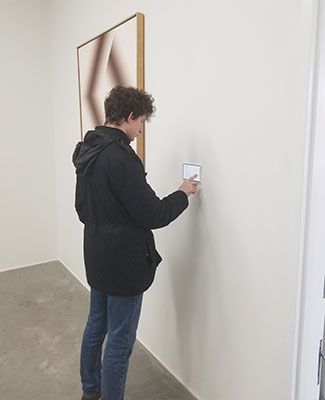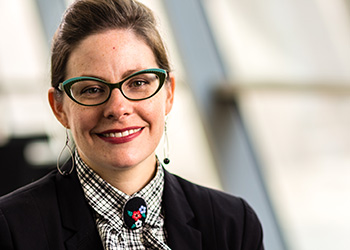Transforming the Exhibit Experience

Transforming the Exhibit Experience
July 12, 2019A $50,000 grant from the Knight Foundation to the Eli and Edythe Broad Art Museum at Michigan State University will help create a system of smart labels that combine ultra-thin touch displays and microcomputers to deliver interactive, informational content about artwork.
While standard content delivery in the form of printed labels and wall text at museums often reach the largest segment of visitors, they pose significant limitations due to static, one-size-fits-all delivery. The MSU Broad is reinventing the content delivery system with help from the Knight Foundation.
“The move toward smart spaces is a very contemporary idea,” said Brian Kirschensteiner, chief preparator at the MSU Broad. “It’s happening in our homes and businesses and needs to happen in museums.”
Kirschensteiner and Associate Curator Steven Bridges worked with a team of MSU students to create “prototype 1” of the new, interactive label this past year, and put their design to the test in an Optical Art exhibition at the MSU Broad Art Lab. The content for the label was created with help from Director of Education at the MSU Broad Michelle Word and Assistant Professor of Psychology Jan Brascamp and his class of MSU psychology students. The students generated the basic text description for the exhibition and built in tiers of content that users can move through depending on their interest. Certain key words are hyperlinked, leading users to additional content.
Museums around the country including the Metropolitan Museum of Art, the Newport Art Museum and Crystal Bridges Museum of American Art have all contacted Kirschensteiner with interest in the technology. While other museums have been using iPads to create layers of content, an iPad on a wall becomes an object. What this team has done is create an interactive label that looks as much like a standard label as possible.
The team is now actively laying the groundwork for “prototype 2.” This version will allow users to ask questions and post comments which will turn white and blend into the wall when not in use and provide analytics to better understand how visitors interact with exhibitions. This idea will further move the museum experience from static and passive towards dynamic and interactive.
Kirschensteiner has no plans to keep this technology self-contained and is actively working on ways to collaborate with peers at other institutions. The team is transforming the future of the museum and helping others do the same.




